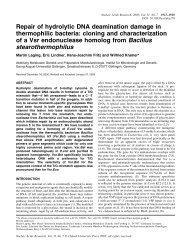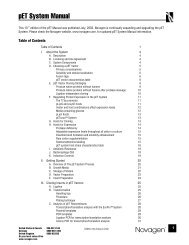DNA Mismatch Repair: Functions and Mechanisms
DNA Mismatch Repair: Functions and Mechanisms
DNA Mismatch Repair: Functions and Mechanisms
You also want an ePaper? Increase the reach of your titles
YUMPU automatically turns print PDFs into web optimized ePapers that Google loves.
<strong>DNA</strong> <strong>Mismatch</strong> <strong>Repair</strong> Chemical Reviews, 2006, Vol. 106, No. 2 317<br />
exposure <strong>and</strong> the demonstration that cisplatin <strong>and</strong> pyrimidine<br />
dimer compound lesions are preferentially recognized by<br />
MutSR are most consistent with the lesion bypass model. In<br />
addition, the finding that ExoI deficiency confers partial<br />
resistance to 6-TG in mouse cells suggests involvement of<br />
excision in the response to this compound (E. Avdievich <strong>and</strong><br />
W. Edelmann, unpublished). On the other h<strong>and</strong>, mouse cells<br />
that harbor a G674A missense mutation within the ATPase<br />
domain of MSH2 display differential defects in mismatch<br />
repair <strong>and</strong> the cisplatin-induced damage response. In contrast<br />
to MSH2-null cells, which are defective in mismatch repair<br />
<strong>and</strong> cisplatin-resistant, cells harboring the G674A allele are<br />
repair defective but remain cisplatin-sensitive, 352 suggesting<br />
that excision is not required for the damage response elicited<br />
by cisplatin. Elucidation of the molecular details responsible<br />
for MutSR- <strong>and</strong> MutLR-dependent damage signaling should<br />
further clarify these issues.<br />
These studies also have implications with respect to genetic<br />
stabilization afforded by the mismatch repair system. Virtually<br />
all of the agents considered in this section, including<br />
the antitumor drugs mentioned above, are mutagens <strong>and</strong><br />
include several well-known carcinogens. Somatic mutations<br />
are believed to contribute in a major way to tumor<br />
development, 353-356 <strong>and</strong> the cancer predisposition associated<br />
with mismatch repair defects has generally been attributed<br />
to the failure to correct <strong>DNA</strong> replication errors. However,<br />
the damage signaling functions of mismatch repair provide<br />
another mechanism by which the system can effectively<br />
stabilize the genome. It is reasonable to assume that<br />
inactivation of the damage-signaling functions of the pathway<br />
also contribute to the cancer predisposition associated with<br />
mismatch repair defects. 325<br />
6. Other <strong>Functions</strong> of <strong>Mismatch</strong> <strong>Repair</strong><br />
6.1. <strong>Mismatch</strong> <strong>Repair</strong> <strong>and</strong> the Fidelity of Genetic<br />
Recombination<br />
MutS <strong>and</strong> MutL homologues modulate the outcome of<br />
mitotic <strong>and</strong> meiotic recombination events in a number of<br />
ways, <strong>and</strong> comprehensive descriptions of these effects can<br />
be found in several recent reviews. 32,33,357 Such effects are<br />
generally not well understood in terms of mechanism.<br />
Consequently, this section will be restricted to consideration<br />
of MutS <strong>and</strong> MutL homologue function in the suppression<br />
of recombination between quasi-homologous <strong>DNA</strong> sequences,<br />
so-called homeologous recombination, a phenomenon<br />
for which mechanistic information is available that can<br />
at least partially account for the observed biological effects.<br />
The genomes of virtually all organisms harbor multiple<br />
copies of related sequence elements; however, the fact that<br />
chromosome rearrangements are rare implies that recombination<br />
between such quasi-homologous sequences is infrequent.<br />
The puzzling nature of this stability became evident with<br />
the demonstration that the activities responsible for recombinational<br />
str<strong>and</strong> transfer readily promote exchange between<br />
<strong>DNA</strong>s that differ significantly at the sequence level. 358,359<br />
Initial clues to the nature of this barrier to exchange between<br />
diverged sequences was provided by E. coli studies, which<br />
demonstrated that inactivation of MutS or MutL dramatically<br />
increases the frequency of homeologous exchanges between<br />
quasi-homologous sequences. 360-363 The biological importance<br />
of this mismatch repair function is dramatically<br />
illustrated by the work of Radman <strong>and</strong> colleagues. 360,363 E.<br />
coli <strong>and</strong> Salmonella typhimurium do not normally exchange<br />
genetic information; however, the presence of a mutS or mutL<br />
mutation within one of these species allows it to incorporate<br />
<strong>DNA</strong> content from the other into its genome. In other words,<br />
the repair system is a major determinant responsible for<br />
definition of the species barrier in bacteria. Subsequent<br />
studies with yeast <strong>and</strong> mammalian cells have demonstrated<br />
similar functions of eukaryotic MutS <strong>and</strong> MutL homologues<br />
in the suppression of homeologous recombination. 32,33 In the<br />
case of human cells, MutSR or MutLR deficiency increases<br />
the rate of gene duplication 50-100-fold, a genetic destabilization<br />
effect attributed to illegitimate recombination that<br />
may contribute to the cancer predisposition conferred by<br />
mismatch repair deficiency. 364<br />
Several molecular features of the anti-recombination<br />
activity of E. coli MutS <strong>and</strong> MutL were revealed by in vitro<br />
analysis of the effects of the two proteins on RecA-mediated<br />
str<strong>and</strong> transfer as a function of the degree of homology of<br />
the <strong>DNA</strong>s involved in the reaction. Although without effect<br />
on RecA-mediated str<strong>and</strong> transfer reactions in which the two<br />
participating <strong>DNA</strong>s were identical (i.e., reactions in which<br />
both <strong>DNA</strong>s are derived from bacteriophage fd or both from<br />
M13), MutS <strong>and</strong> MutL block homeologous str<strong>and</strong> transfer<br />
between fd <strong>and</strong> M13, which differ by 3% at the sequence<br />
level. 365 High concentrations of MutS alone are sufficient to<br />
suppress fd-M13 str<strong>and</strong> exchange, but MutL dramatically<br />
potentiates this effect at reduced MutS concentrations. Mutant<br />
forms of MutS, which retain mismatch recognition activity<br />
but lack ATPase function due to amino acid substitutions<br />
within the Walker A motif, also suppress fd-M13 str<strong>and</strong><br />
transfer. However, MutL fails to enhance this effect, suggesting<br />
that MutS ATP hydrolysis is required for MutL<br />
function in this manner. 251 Examination of str<strong>and</strong> transfer<br />
intermediates produced during fd-M13 str<strong>and</strong> exchange has<br />
demonstrated that str<strong>and</strong> transfer initiates in the presence of<br />
MutS <strong>and</strong> MutL <strong>and</strong> that the mismatch repair proteins block<br />
the branch migration step of str<strong>and</strong> assimilation. 365 This<br />
suggests that MutS <strong>and</strong> MutL are able to access mismatched<br />
base pairs within early str<strong>and</strong> transfer intermediates <strong>and</strong> that<br />
this serves to block branch migration. Inasmuch as RecA<br />
str<strong>and</strong> transfer products reside within a nucleoprotein filament,<br />
366 MutS <strong>and</strong> MutL are apparently able to access<br />
mispairs within this structure, but the mechanism by which<br />
this occurs is not clear. It is noteworthy that yeast genetic<br />
studies support the view that MutS <strong>and</strong> MutL homologues<br />
intervene in homeologous exchange by blocking the branch<br />
migration step of str<strong>and</strong> transfer. Thus, gene conversion tracts<br />
produced by exchange between quasi-homologous sequences<br />
in mismatch repair-deficient cells are substantially longer<br />
than those observed in otherwise isogenic repair-proficient<br />
cells. 367,368<br />
The homeologous branch migration intermediates that are<br />
trapped by MutS <strong>and</strong> MutL have been postulated to undergo<br />
a disassembly reaction, 365 but the fate of such structures has<br />
not been established. It also is pertinent to note in this regard<br />
that the fate of mispairs within a homeologous str<strong>and</strong> transfer<br />
intermediate need not be the same as that for mismatches<br />
that arise at the replication fork. For example, the fate of<br />
the MutS‚MutL‚mismatch complex that occurs within a<br />
recombination intermediate could be dictated by its presence<br />
within the context of the RecA nucleoprotein filament.<br />
6.2. <strong>Mismatch</strong> <strong>Repair</strong> <strong>and</strong> Triplet Repeat<br />
Instability<br />
Trinucleotide repeat expansion is the cause of several<br />
common neurodegenerative diseases such as myotonic




